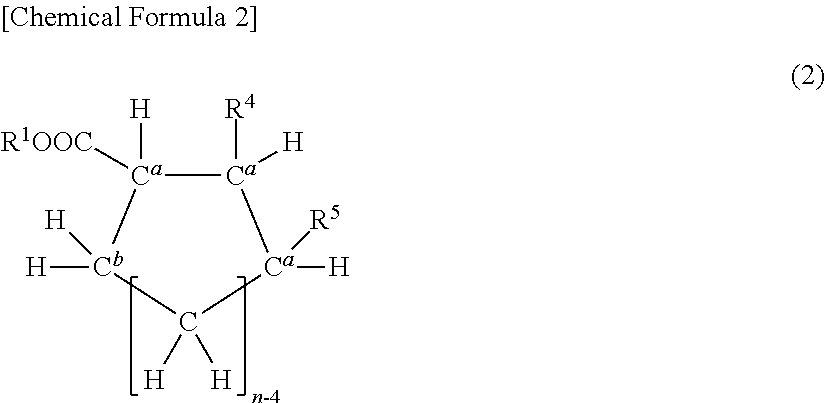Polypropylene for film capacitor, biaxially stretched film for film capacitor, film capacitor, and process for producing the same
a technology of polypropylene and film capacitor, which is applied in the direction of stacked capacitors, fixed capacitor details, etc., can solve the problems that polypropylenes with improved stereoregularity have not been able to provide films having a sufficient breakdown voltage, capacitors that cannot meet the market demand, and films having high bdv especially at high temperatures cannot be obtained using polypropylenes. , to achieve the effect of small thermal shrinkage ratio, high breakdown voltage and sufficient breakdown voltag
- Summary
- Abstract
- Description
- Claims
- Application Information
AI Technical Summary
Benefits of technology
Problems solved by technology
Method used
Image
Examples
production example 1
of Propylene Homopolymer (PP1)
(1) Preparation of Solid Catalyst
[0142]A high-speed stirring apparatus having an internal volume of 2 L (product name: TK homomixer M type, manufactured by Tokushu Kika Kogyo Co., Ltd.) was thoroughly purged with nitrogen. Thereafter, 700 mL of purified decane, 10 g of magnesium chloride, 24.2 g of ethanol and 3 g of Reodol (registered trademark) SP-S20 (trade name, manufactured by Kao Corporation, sorbitan distearate) were placed in this apparatus. Then, with stirring this suspension, the apparatus was heated, and the suspension was stirred at 800 rpm for 30 minutes at 120° C. Subsequently, with stirring this suspension at a high speed so that a precipitate should not be formed, the suspension was transferred into a 2-L glass flask (equipped with stirrer) containing 1 L of purified decane having been cooled to −10° C. in advance, by the use of a Teflon (registered trademark) tube having an inner diameter of 5 mm. A solid adduct having been formed by th...
production example 2
of Propylene Homopolymer (PP2)
(1) Preparation of Solid Catalyst
[0151]300 g of anhydrous magnesium chloride, 1.6 L of kerosine, and 1.5 L of 2-ethylhexyl alcohol were heated at 140° C. for 3 hours to prepare a homogeneous solution. To the solution, 70 g of phthalic anhydride was added, then they were stirred at 130° C. for 1 hour to dissolve the phthalic anhydride, and thereafter, the solution was cooled down to room temperature. Further, the solution was dropwise added slowly to 8.5 L of titanium tetrachloride having been cooled to −20° C. After completion of the dropwise addition, the temperature was raised up to 110° C., then 215 mL of diisobutyl phthalate was added, and the mixture was stirred for 2 hours. The resulting solid was separated by hot filtration, then the solid was suspended in 10 L of titanium tetrachloride again, and the suspension was stirred at 110° C. for 2 hours again. The resulting solid was separated by hot filtration, and the solid was washed with n-heptane u...
production example 3
of Propylene Homopolymer (PP3)
[Preparation of Solid Titanium Catalyst Component (a)]
[0154]952 g of anhydrous magnesium chloride, 4420 mL of decane, and 3906 g of 2-ethylhexyl alcohol were heated at 130° C. for 2 hours, thereby providing a homogenous solution. Into the solution, 213 g of phthalic anhydride was added, which was followed by further stirring and mixing at 130° C. for 1 hour so as to dissolve the phthalic anhydride.
[0155]A homogenous solution thus obtained was cooled to 23° C., and 750 mL of this homogenous solution was added dropwise over 1 hour into 2000 mL of titanium tetrachloride held at −20° C. After the dropwise addition, the temperature of the obtained mixture solution was raised to 110° C. over 4 hours. When the temperature was reached 110° C., 52.2 g of diisobutyl phthalate (DIBP) was added, and the temperature was maintained at the same level with stirring for 2 hours. Subsequently, a solid was collected by hot filtration, and the solid was resuspended in 2750...
PUM
| Property | Measurement | Unit |
|---|---|---|
| melting point | aaaaa | aaaaa |
| melt flow rate | aaaaa | aaaaa |
| melting point | aaaaa | aaaaa |
Abstract
Description
Claims
Application Information
 Login to View More
Login to View More - R&D
- Intellectual Property
- Life Sciences
- Materials
- Tech Scout
- Unparalleled Data Quality
- Higher Quality Content
- 60% Fewer Hallucinations
Browse by: Latest US Patents, China's latest patents, Technical Efficacy Thesaurus, Application Domain, Technology Topic, Popular Technical Reports.
© 2025 PatSnap. All rights reserved.Legal|Privacy policy|Modern Slavery Act Transparency Statement|Sitemap|About US| Contact US: help@patsnap.com



